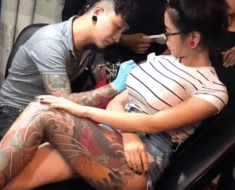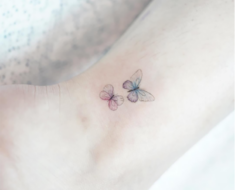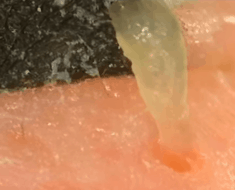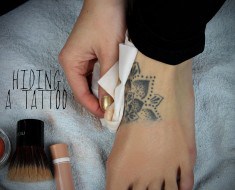
Welcome to our article addressing the concerns of individuals undergoing tattoo removal. One common worry that often comes up is whether the procedure will leave scars. In this section, we will explore the potential marks that may result from tattoo removal and provide guidance on how to heal with confidence.
Tattoo removal is a process that involves removing unwanted tattoos from the skin. It is often done using laser technology, which breaks down the ink particles present in the tattoo. The fragmented ink is then eliminated by the body’s immune system.
However, individuals may wonder if scars can form during this process. Various factors can influence the likelihood of scarring, such as skin type, tattoo size, color, and the technique used by professionals. By examining these factors, we can gain insights into the potential risks and understand how to minimize scarring.
After completing the tattoo removal procedure, proper healing is crucial to minimize the chances of scarring. It is important to follow recommended aftercare practices, including skincare routines, moisturization, and sun protection. By following these guidelines, individuals can promote the healing of their skin and achieve the desired results.
In conclusion, while concerns about scarring during tattoo removal are understandable, it is possible to minimize the likelihood of marks by understanding the procedure, discussing possible scarring factors, and implementing proper aftercare. We want to ensure you heal with confidence and achieve the results you desire.
Understanding the Tattoo Removal Process
Welcome to the fascinating world of tattoo removal! In this section, we will take a deep dive into the tattoo removal process to help you better understand how it works and what to expect. From laser technology to the role of your immune system, we’ll cover it all. So let’s get started!
When it comes to removing a tattoo, laser technology is the key player. Laser tattoo removal is a highly effective method that uses targeted beams of light to break down the ink particles trapped in your skin. The laser’s energy is absorbed by the pigments in your tattoo, causing them to shatter into smaller fragments.
Once the ink particles are fragmented, your immune system comes into action. Your body’s natural defense mechanism recognizes these foreign particles and starts the process of eliminating them. Over time, the immune system flushes out the fragmented ink particles through your lymphatic system.
Now, you might be wondering about the potential effects on your skin. Don’t worry, laser tattoo removal is designed to minimize damage to the surrounding skin while focusing on the ink particles. The laser targets the pigments without harming the healthy tissue, allowing for a safer and more precise procedure.
It’s important to note that the tattoo removal process requires multiple sessions, usually spaced several weeks apart, to allow your body’s immune system enough time to eliminate the fragmented ink. Patience is key in this process, as the number of sessions needed will depend on various factors, such as the size, color, and saturation of your tattoo.
So, if you are considering tattoo removal, understanding the process is crucial. Laser technology, ink particle fragmentation, and your immune system all play a vital role in achieving the desired results. Stay tuned for our next section, where we will discuss the possibility of scarring in the tattoo removal process.
Discussing Possible Scarring
When it comes to tattoo removal, one concern that often arises is the possibility of scarring. While the goal is to have a clean slate, it’s important to understand that scarring can occur as a result of the removal process. However, various factors influence the likelihood of scarring, and by considering these factors, individuals can take steps to minimize the risks.
Skin type plays a significant role in the potential for scarring. Generally, individuals with sensitive or easily scarred skin may be more prone to scarring during tattoo removal. It is important to consult with a professional who can assess your skin type and recommend the best approach to minimize scarring.
The tattoo size and color also play a part. Larger tattoos may require multiple sessions, increasing the chances of scarring if not treated properly. Darkly colored tattoos, especially those with dense ink, may also pose a higher risk of scarring. Additionally, tattoos located in areas with thin skin, such as the wrists or collarbone, may be more susceptible to scarring.
The professional technique used in the tattoo removal process is crucial. Experienced professionals who use advanced laser technology and follow best practices minimize the risk of scarring. It is important to choose a reputable clinic or technician who has a track record of successful and safe tattoo removal procedures.
While there is no foolproof way to guarantee that scarring will not occur, individuals can take measures to reduce the likelihood. By discussing their concerns with a professional, understanding their skin type, carefully considering the size and color of their tattoo, and ensuring they are in the hands of a skilled technician, individuals can make informed decisions and minimize the potential for scarring during the tattoo removal process.
Ensuring a Successful Healing Process
Proper aftercare is crucial for a successful healing process after tattoo removal. By following these essential tips, you can promote the healing of your skin and minimize the chances of scarring.
1. Aftercare Instructions
Listen carefully to your tattoo removal specialist and follow their aftercare instructions. These instructions are tailored to your specific situation and will guide you through the healing process.
2. Skincare Routines
Establish a skincare routine that focuses on gentle cleansing and moisture. Use a mild, fragrance-free cleanser to gently cleanse the treated area twice a day. After cleansing, apply a thin layer of a recommended moisturizer to keep the skin hydrated and promote healing. Avoid applying any harsh or scented products that may irritate the skin.
3. Moisturization
Moisturizing the treated area is essential to prevent dryness and promote healing. Apply a designated tattoo aftercare moisturizer regularly throughout the day. Gently massage the moisturizer into the skin to enhance absorption and nourishment.
4. Sun Protection
Protect the treated area from direct sunlight, as UV rays can hinder the healing process and increase the risk of scarring. Apply a broad-spectrum sunscreen with an SPF of 30 or higher whenever you are exposed to the sun. Consider wearing protective clothing or using a sun-protective film or bandage to shield the area.
By prioritizing aftercare, establishing a consistent skincare routine, regular moisturization, and diligent sun protection, you can ensure a successful healing process after tattoo removal. Following these guidelines will promote healthy skin regeneration and minimize the chances of scarring, allowing you to embrace your tattoo-free skin confidently.
Conclusion
In conclusion, many individuals undergoing tattoo removal may have concerns about the possibility of scarring. However, it is important to note that with the right knowledge and proper aftercare, the likelihood of marks can be significantly reduced.
By understanding the tattoo removal procedure, individuals can have a clearer picture of how it works and the potential effects it may have on their skin. This understanding allows them to make informed decisions and approach the process with confidence.
Moreover, discussing possible scarring factors such as skin type, tattoo size, color, and the technique used by professionals is crucial. By addressing these factors before undergoing tattoo removal, individuals can minimize the risks and ensure a more successful outcome.
Lastly, implementing proper aftercare is key to promoting healing and reducing the chances of scarring. Following a skincare routine, moisturizing the treated area, and protecting it from the sun’s harmful rays are all essential steps to achieve the desired skin appearance.









































